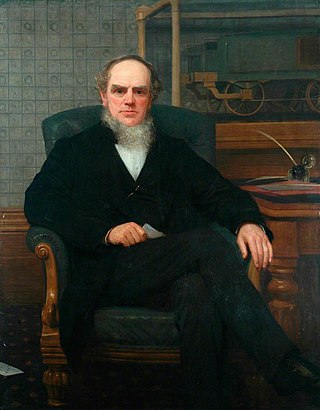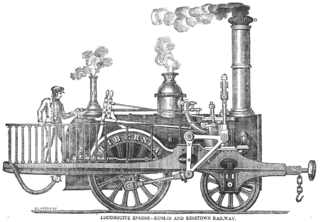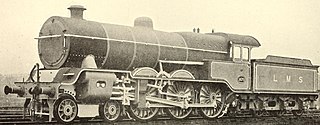
The London and North Western Railway was a British railway company between 1846 and 1922. In the late 19th century, the LNWR was the largest joint stock company in the world.
George Hughes was an English locomotive engineer, and chief mechanical engineer (CME) of the Lancashire and Yorkshire Railway (L&YR) and the London, Midland and Scottish Railway (LMS).

Francis William Webb was an English railway engineer, responsible for the design and manufacture of locomotives for the London and North Western Railway (LNWR). As the LNWR's chief mechanical engineer, he also exercised great influence in political and public life in the Cheshire town of Crewe, once being described as the 'King of Crewe'.

Henry Alfred Ivatt was an English railway engineer, and was the Chief Mechanical Engineer of the Great Northern Railway from 1896 to 1911.
Hewitt Pearson Montague Beames was Chief Mechanical Engineer of the London and North Western Railway from 1920 to 1922.

John Ramsbottom was an English mechanical engineer. Born in Todmorden, then on the county border of Yorkshire and Lancashire. He was the Chief Mechanical Engineer for the London and North Western Railway for 14 years. He created many inventions for railways but his main legacy is the split metal piston ring, virtually all reciprocating engines continue to use these today.

Crewe Works is a British railway engineering facility located in the town of Crewe, Cheshire. The works, which was originally opened by the Grand Junction Railway in March 1843, employed around 7,000 to 8,000 workers at its peak. In the 1980s much of the engineering works were closed. Most of the site has been redeveloped, but the remaining parts are owned and operated by Alstom.

The Dublin and Kingstown Railway (D&KR), which opened in 1834, was Ireland's first passenger railway. It linked Westland Row in Dublin with Kingstown Harbour in County Dublin.

James Edward McConnell (1815–1883) was one of the first locomotive engineers of the London and North Western Railway (LNWR). He was Locomotive Superintendent of the LNWR's Southern Division at Wolverton railway works from 1847 to 1862 and oversaw the design of the "Bloomer" and "Patent" locomotives. He was also one of the founding members of the Institution of Mechanical Engineers, and its first chairman, discussing the issue of an institute in 1846 at Bromsgrove.

Francis Trevithick (1812–1877), from Camborne, Cornwall, was one of the first locomotive engineers of the London and North Western Railway (LNWR).
George Forrester and Company was a British marine engine and locomotive manufacturer at Vauxhall Foundry in Liverpool, established by Scottish engineer George Forrester. The company opened in 1827 as iron founders and commenced building steam locomotives in 1834.

Hibernia was a steam locomotive designed by Richard Roberts and built by Sharp, Roberts and Company in 1834 for the Dublin and Kingstown Railway (D&KR). The locomotive had vertical cylinders driving via bell cranks.

The Lancashire and Yorkshire Railway (L&YR) Class 8 was a four-cylinder 4-6-0 express passenger locomotive designed by George Hughes introduced in 1908.

The London and North Western Railway (LNWR) "Precursor" Class was a type of 4-4-0 ("American") steam locomotive designed by the company's Chief Mechanical Engineer, George Whale. Introduced in 1904, it should not be confused with the LNWR 2-4-0 "Precursor" Class of 1874 designed by Francis Webb, the last example of which was scrapped in 1895. In 1906, a 4-4-2T ("Atlantic") tank variant of Webb's engine, the "Precursor Tank" Class, also entered service.

The LNWR 4ft 6in Tank was a class of 220 passenger 2-4-2T locomotives manufactured by the London and North Western Railway in their Crewe Works between 1879 and 1898. The "4ft 6in" in the title referred to the diameter of the driving wheels – although the stated dimension was for the wheel centres – the nominal diameter including the tyres was 4 ft 8+1⁄2 in (1,435 mm).

The LNWR 18-inch Tank class was a class of 80 0-6-2T locomotives built by the London and North Western Railway in their Crewe Works between 1898 and 1902.
Grand Canal Street railway works, also known as The Factory, served the Dublin and Kingstown Railway (D&KR), its successors the Dublin, Wicklow and Wexford Railway (DW&WR) and the Dublin and South Eastern Railway (DSER). It was preceded by a small "engine hospital" maintenance depot at Serpentine Avenue.

The LNWR Newton Class was a class of ninety-six 2-4-0 steam locomotives built by the London and North Western Railway at their Crewe Works between 1866 and 1873.

The LNWR Samson Class was a class of ninety 2-4-0 steam locomotives built by the London and North Western Railway at their Crewe Works between 1863 and 1879.

Swiftsure was first of eight or more similar locomotives with a single pair of driving wheels built by George Forrester and Company (Forresters) from 1834. The tank variant was the first passenger tank engine to enter service in the world.

















